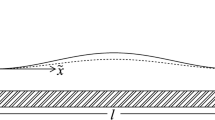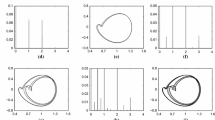Abstract
This study focuses on nonlinear modal resonant dynamics of a buckled beam coupled with a boundary massive oscillator. To reveal buckled beam–boundary oscillator coupling effect, extended Hamilton principle is employed to derive a dynamic model with geometric nonlinearity included, and direct multiple-scale method (i.e., attacking directly partial differential equations) is then applied to reduce the original infinite-dimensional beam–support coupled system, leading to nonlinear modulation equations characterizing reduced slow dynamics of the coupled system, by focusing on beam’s one-to-one internally resonant dynamics around its first buckled shape. Time history responses, frequency responses, and Poincaré mapping are employed to investigate stability/bifurcation of nonlinear forced coupled dynamics, with one-to-one internal resonance activated or not.















Similar content being viewed by others
Data availability
All data in this study will be made available on reasonable request.
References
Rega, G., Settimi, V., Lenci, S.: Chaos in one-dimensional structural mechanics. Nonlinear Dyn. 102, 785–834 (2020)
Lacarbonara, W.: A theoretical and experimental investigation of nonlinear vibrations of buckled beams. PhD thesis, Virginia Polytechnic Institute and State University (1997)
Nayfeh, A.H., Lacarbonara, W., Chin, C.M.: Nonlinear normal modes of buckled beams: three-to-one and one-to-one internal resonances. Nonlinear Dyn. 18, 253–273 (1999)
Emam, S.A.: A theoretical and experimental study of nonlinear dynamics of buckled beams, PhD thesis. Virginia Polytechnic Institute and State University (2002)
Emam, S.A., Nayfeh, A.H.: On the nonlinear dynamics of a buckled beam subjected to a primary-resonance excitation. Nonlinear Dyn. 35, 1–17 (2004)
Emam, S.A., Nayfeh, A.H.: Nonlinear responses of buckled beams to subharmonic-resonance excitations. Nonlinear Dyn. 35, 105–122 (2004)
Nayfeh, A.H., Emam, S.A.: Exact solution and stability of postbuckling configurations of beams. Nonlinear Dyn. 54, 395–408 (2008)
Emam, S.A., Nayfeh, A.H.: Non-linear response of buckled beams to 1:1 and 3:1 internal resonances. Int. J. Nonlinear Mech. 52, 12–15 (2013)
Huang, J.L., Xiao, L.J., Zhu, W.D.: Investigation of quasi-periodic response of a buckled beam under harmonic base excitation with an “unexplained” sideband structure. Nonlinear Dyn. 100, 2103–2119 (2020)
Coaquira, J.C., Cardoso, D.C.T., Goncalves, P.B., Orlando, D.: Parametric instability and nonlinear oscillations of an FRP channel section column under axial load. Nonlinear Dyn. 103, 3557–3580 (2021)
Liu, C.R., Yu, K.P.: Accurate modeling and analysis of a typical nonlinear vibration isolator with quasi-zero stiffness. Nonlinear Dyn. 100, 2141–2165 (2020)
Liu, C.R., Yu, K.P.: Superharmonic resonance of the quasi-zero-stiffness vibration isolator and its effect on the isolation performance. Nonlinear Dyn. 100, 95–117 (2020)
Bouna, H.S., Nbendjo, B.R.N., Woafo, P.: Isolation performance of a quasi-zero stiffness isolator in vibration isolation of a multi-span continuous beam bridge under pier base vibrating excitation. Nonlinear Dyn. 100, 1125–1141 (2020)
Iurasov, V., Mattei, P.O.: Bistable nonlinear damper based on a buckled beam configuration. Nonlinear Dyn. 99, 1801–1822 (2019)
Alcheikh, N., Mbarek, S.B., Ouakad, H.M., Younis, M.I.: A highly sensitive and wide-range resonant magnetic micro-sensor based on a buckled micro-beam. Sens. Actuator Phys. 328(1), 112768 (2021)
Huguet, T., Lallart, M., Badel, A.: Bistable vibration energy harvester and SECE circuit: exploring their mutual influence. Nonlinear Dyn. 97, 485–501 (2019)
Derakhshani, M., Berfield, T.A., Murphy, K.D.: A component coupling approach to dynamic analysis of a buckled, bistable vibration energy harvester structure. Nonlinear Dyn. 96, 1429–1446 (2019)
Torteman, B., Kessler, Y., Liberzon, A., Krylov, S.: Micro-beam resonator parametrically excited by electro-thermal Joule’s heating and its use as a flow sensor. Nonlinear Dyn. 98, 3051–3065 (2019)
Lu, L., She, G.L., Guo, X.M.: Size-dependent postbuckling analysis of graphene reinforced composite microtubes with geometrical imperfection. Int. J. Mech. Sci. 199, 106428 (2021)
Emam, S.A., Lacarbonara, W.: A review on buckling and postbuckling of thin elastic beams. Eur. J. Mech. A/Solids. 92, 10449 (2022)
Min, G.B., Eisley, J.G.: Nonlinear vibration of buckled beams. J. Eng. Ind. 94, 637 (1972)
McDonald, P.H., Jr.: Nonlinear dynamic coupling in a beam vibration. J. Appl. Mech. 22, 573–578 (2021)
Tseng, W.Y., Dugundji, J.: Nonlinear vibrations of a buckled beam under harmonic excitation. J. Appl. Mech. 38, 467–476 (1971)
Kreider, W., Nayfeh, A.H.: Experimental investigation of single-mode responses in a fixed-fixed buckled beam. Nonlinear Dyn. 15, 155–177 (1998)
Lestari, W., Hanagud, S.: Nonlinear vibration of buckled beams: some exact solutions. Int. J. Solids Struct. 38, 4741–4757 (2001)
Lacarbonara, W., Arafat, H.N., Nayfeh, A.H.: Non-linear interactions in imperfect beams at veering. Int. J. Nonlinear Mech. 40, 987–1003 (2005)
Emam, S.A.: A static and dynamic analysis of the postbuckling of geometrically imperfect composite beams. Compos. Struct. 90, 247–253 (2009)
Celebi, K., Yarimpabuc, D., Tutuncu, N.: Free vibration analysis of functionally graded beams using complementary functions method. Arch. Appl. Mech. 88, 34–47 (2018)
Pi, Y.L., Bradford, M.A., Tin-Loi, F.: Nonlinear analysis and buckling of elastically supported circular shallow arches. Int. J. Solids Struct. 44, 2401–2425 (2007)
Luongo, A., Rega, G., Vestroni, F.: On nonlinear dynamics of planar shear indeformable beams. J. Appl. Mech. 53, 619–624 (1986)
Lacarbonara, W., Yabuno, H.: Refined models of elastic beams undergoing large in-plane motions: theory and experiment. Int. J. Solids Struct. 43, 5066–5084 (2006)
Lenci, S., Clementi, F., Rega, G.: A comprehensive analysis of hardening/softening behaviour of shearable planar beams with whatever axial boundary constraint. Meccanica 51, 2589–2606 (2016)
Lenci, S., Clementi, F., Kloda, L., Warminski, J., Rega, G.: Longitudinal–transversal internal resonances in Timoshenko beams with an axial elastic boundary condition. Nonlinear Dyn. 103, 3489–3513 (2021)
Lenci, S., Rega, G.: Nonlinear free vibrations of planar elastic beams: a unified treatment of geometrical and mechanical effects. Procedia IUTAM. 19, 35–42 (2016)
Perkins, N.C.: Modal interactions in the non-linear response of elastic cables under parametric/external excitation. Int. J. Nonlinear Mech. 27, 233–250 (1992)
Guo, T.D., Kang, H.J., Wang, L.H., Zhao, Y.Y.: Cable dynamics under non-ideal support excitations: nonlinear dynamic interactions and asymptotic modelling. J. Sound Vib. 384, 253–272 (2016)
Guo, T.D., Kang, H.J., Wang, L.H., Liu, Q.J., Zhao, Y.Y.: Modal resonant dynamics of cables with a flexible support: a modulated diffraction problem. Mech. Syst. Signal Process. 106, 229–248 (2018)
Qiao, W.Z., Guo, T.D., Kang, H.J., Zhao, Y.Y.: An asymptotic study of nonlinear coupled vibration of arch-foundation structural system. Eur. J. Mech. A/Solids. 96, 104711 (2022)
Qiao, W.Z., Guo, T.D., Kang, H.J., Zhao, Y.Y.: Nonlinear vibration analysis of a shallow arch coupled with an elastically constrained rigid body. Nonlinear Dyn. 111, 10769–10789 (2023)
Touzé, C., Vizzaccaro, A., Thomas, O.: Model order reduction methods for geometrically nonlinear structures: a review of nonlinear techniques. Nonlinear Dyn. 105, 1141–1190 (2021)
Mehmet, P.: A comuadratic and cubic nonlinearities. Mech. Res. Commun. 21, 203–208 (1994)
Nayfeh, A.H., Lacarbonara, W.: On the discretization of distributed-parameter systems with quadratic and cubic nonlinearities. Nonlinear Dyn. 13, 203–220 (1997)
Lacarbonara, W.: Direct treatment and discretizations of non-linear spatially continuous systems. J. Sound Vib. 221, 849–866 (1999)
Howes, F.A.: Introduction to Perturbation Techniques. Wiley-Interscience, NewYork (1981)
Lacarbonara, W., Rega, G., Nayfeh, A.H.: Resonant non-linear normal modes. Part I: analytical treatment for structural one-dimensional systems. Int. J. Nonlinear Mech. 38, 851–872 (2003)
Ermentrout, B.: Simulating, analyzing, and animating dynamical systems: a guide to XPPAUT for researchers and students. Society for Industrial and Applied Mathematics (1987)
Krauskopf, B., Osinga, H.M., Galán-Vioque, J.: Numerical Continuation Methods for Dynamical Systems. Springer (2007)
Guo, T.D., Rega, G.: Reduced-order modelling of geometrically nonlinear structures. Part 2: correspondence and unified perspectives on different reduction techniques. Nonlinear Dyn. (2023). https://doi.org/10.1007/s11071-023-08745-8
Funding
This study is supported by the National Science Foundation of China under Grant Nos. 12372007, 11872176, 11972151, 12202109 and also by Guangxi Science & Technology Base and Talent Project under grant No. 2020AC19209.
Author information
Authors and Affiliations
Corresponding author
Ethics declarations
Conflict of interest
The authors have no conflicts of interest relevant to the current article.
Additional information
Publisher's Note
Springer Nature remains neutral with regard to jurisdictional claims in published maps and institutional affiliations.
Appendices
Appendix A
The variational process of kinetic energy is as follows:
Also, the variational process of potential energy is as follows:
The details above are given below
In a similar way, the variational process of virtual work is as follows:
Note that one key constraint above is \(\delta \hat{g}\left( {\hat{t}} \right) = \delta \hat{u}\left( {l,\hat{t}} \right)\), which is due to the beam-support interface connection condition \(\hat{u}\left( {l,\hat{t}} \right) = \hat{g}\left( {\hat{t}} \right)\).
Appendix B
The buckled beam’s linear mode shapes \(\phi_{k} (x)\), around the first buckled mode \(y(x) = 0.5 \times b(1 - \cos 2\pi x),\;\;b = {{2\sqrt {P - 4\pi^{2} } } \mathord{\left/ {\vphantom {{2\sqrt {P - 4\pi^{2} } } \pi }} \right. \kern-0pt} \pi }\), are derived by solving the following boundary-value problem [7]
Explicitly, one has
where
the \(c_{i}\) and \(\omega_{k}\) in the mode shapes are solutions to the following algebraic eigenvalue problem [7]:
Typical mode shapes are depicted in Fig. 15
.
Appendix C
The shape functions used in Eq. (31) are governed by the following linear boundary-value problems (BVP)
with boundary conditions \(\Psi_{ij} (0) = \Psi_{ij} (1) = 0, \, \chi_{ij} (0) = \chi_{ij} (1) = 0\). Recall that the linear structural operator is defined as \(L[w] = w^{iv} + 4\pi^{2} w^{\prime \prime } - y^{\prime\prime}\int_{0}^{1} {y^{\prime } w^{\prime } } {\text{d}}x\).
Appendix D
Rights and permissions
Springer Nature or its licensor (e.g. a society or other partner) holds exclusive rights to this article under a publishing agreement with the author(s) or other rightsholder(s); author self-archiving of the accepted manuscript version of this article is solely governed by the terms of such publishing agreement and applicable law.
About this article
Cite this article
Chen, H., Guo, T., Qiao, W. et al. Nonlinear resonant response of a buckled beam coupled with a boundary massive oscillator. Nonlinear Dyn 112, 3217–3240 (2024). https://doi.org/10.1007/s11071-023-09239-3
Received:
Accepted:
Published:
Issue Date:
DOI: https://doi.org/10.1007/s11071-023-09239-3





